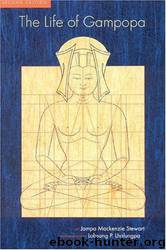The Life of Gampopa by Jampa Mackenzie Stewart

Author:Jampa Mackenzie Stewart
Language: eng
Format: azw3
Tags: Religious, General, Religion, Buddhism, Biography & Autobiography, Tibetan, History
ISBN: 9781559392143
Publisher: Snow Lion Publications
Published: 2004-06-01T14:43:00+00:00
The Kagyupa order is a loose conglomerate of monastic centers, each of which functions independently, while remaining loyal to the common history and heritage-rather like a necklace with many strings. This is in contrast to its sister order, the Gelugpa, which maintains a homogeneous character with a single institutional entity and functional coherence-somewhat like a stringed instrument.
The term Kagyupa means "Adherents of the Secret Oral Transmission." The syllable ka stands for "oral teachings"; gyu for "transmission" (from teacher to disciple-originally restricted to a one-to-one relationship); the pa means "adherents". Sometimes, however, ka (spelled bKa) was pronounced as kar (spelled dKar), which means "white robe", and originated from the white cotton robe worn by the Kagyupa saint Milarepa during his years as a hermit.
As the monastic centers of various Kagyupa schools multiplied, so did their lay devotees all across the country. During the early stage of Kagyu history, four large orders (called "elder") and eight small orders (called "younger") were established. The Kagyupas, like other schools, were the creation of individual Tibetan teachers. These independent orders were generally influenced by the personalities and preferences of their respective founders. By maintaining and passing on to disciples the distinct practices of self-realization taught by their founders, the unique traditions of the various lineages were upheld.
The immediate source of the Kagyupa esoteric teachings were the mahasiddhas (the "Great Realized Ones"), the wandering ascetic teachers of the Indian subcontinent. They were widely recognized and highly revered for their wisdom, miraculous powers, and their complete detachment from any materialistic and selfish concerns. Often they were called "crazy yogins" on account of their unconventional behavior, stunning wit and wisdom, and carefree life-style. Their life stories and songs (dohas) challenge institutional and individual corruption and confusion. The best known amongst the Tibetan crazy yogins is Drukpa Kunley Born in 1455, he was supposed to have lived to 115 years of age.
Principal among a host of Indian mahasiddhas were Tilopa, Maitripa, Naropa, and Savaripa, all of whom lived during the tenth to twelfth centuries. These, together with their predecessors, constitute the "blessing lineage of self-realization practices." The earlier line of teachers included the exalted Asanga, Saraha ("the Sovereign of all Realized Ones") and Nagarjuna, and was linked all the way back to the historical Buddha.
Download
This site does not store any files on its server. We only index and link to content provided by other sites. Please contact the content providers to delete copyright contents if any and email us, we'll remove relevant links or contents immediately.
| Buddhism | Christianity |
| Ethnic & Tribal | General |
| Hinduism | Islam |
| Judaism | New Age, Mythology & Occult |
| Religion, Politics & State |
Cecilia; Or, Memoirs of an Heiress — Volume 1 by Fanny Burney(31341)
Cecilia; Or, Memoirs of an Heiress — Volume 3 by Fanny Burney(30938)
Cecilia; Or, Memoirs of an Heiress — Volume 2 by Fanny Burney(30896)
The Secret History by Donna Tartt(16644)
Sapiens: A Brief History of Humankind by Yuval Noah Harari(13067)
Leonardo da Vinci by Walter Isaacson(11913)
The Radium Girls by Kate Moore(10914)
Sapiens by Yuval Noah Harari(4546)
The Wind in My Hair by Masih Alinejad(4427)
How Democracies Die by Steven Levitsky & Daniel Ziblatt(4407)
Homo Deus: A Brief History of Tomorrow by Yuval Noah Harari(4287)
Endurance: Shackleton's Incredible Voyage by Alfred Lansing(3852)
The Silk Roads by Peter Frankopan(3771)
Man's Search for Meaning by Viktor Frankl(3644)
Millionaire: The Philanderer, Gambler, and Duelist Who Invented Modern Finance by Janet Gleeson(3574)
The Rape of Nanking by Iris Chang(3522)
Hitler in Los Angeles by Steven J. Ross(3443)
The Motorcycle Diaries by Ernesto Che Guevara(3340)
Joan of Arc by Mary Gordon(3263)
